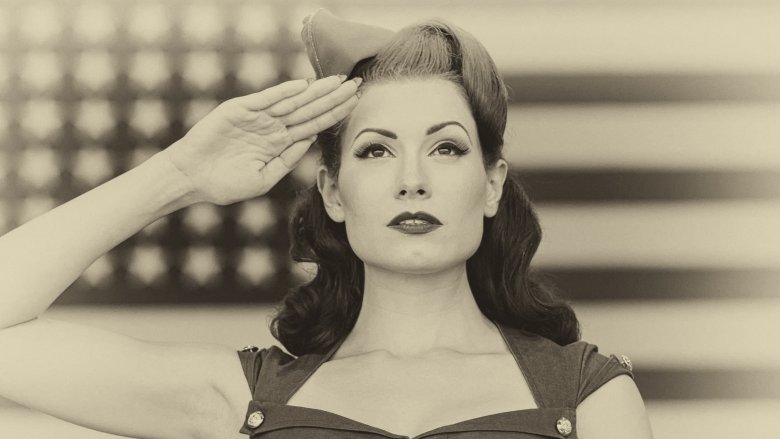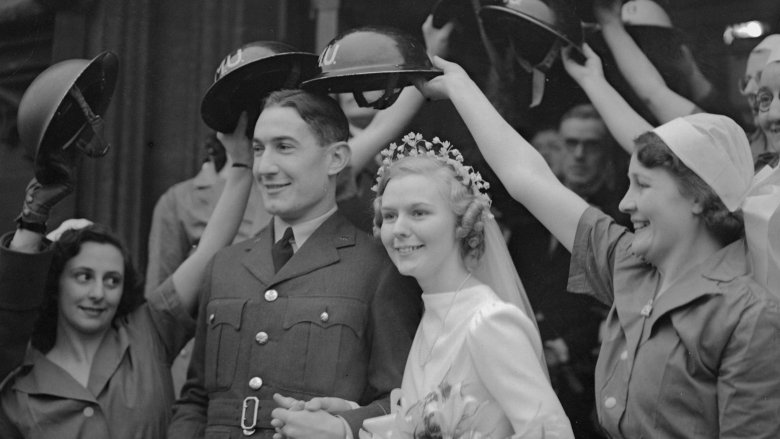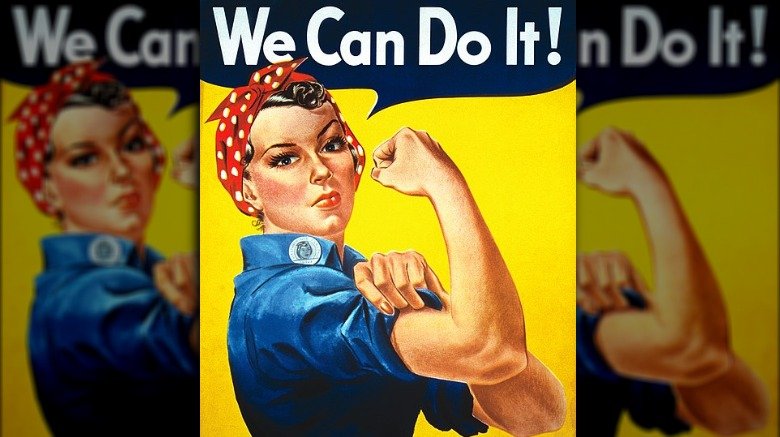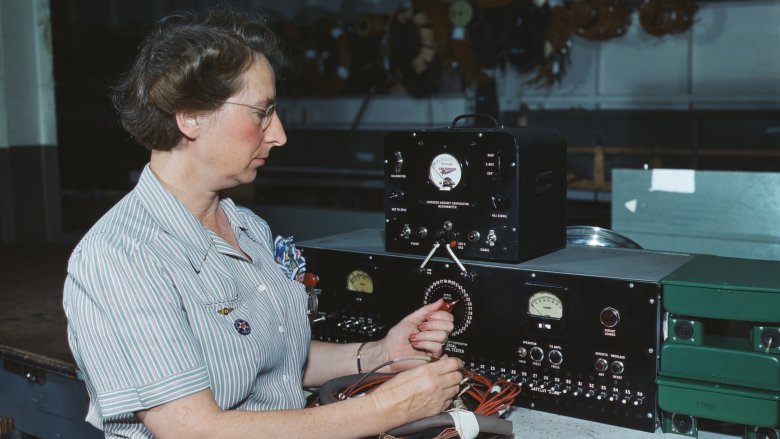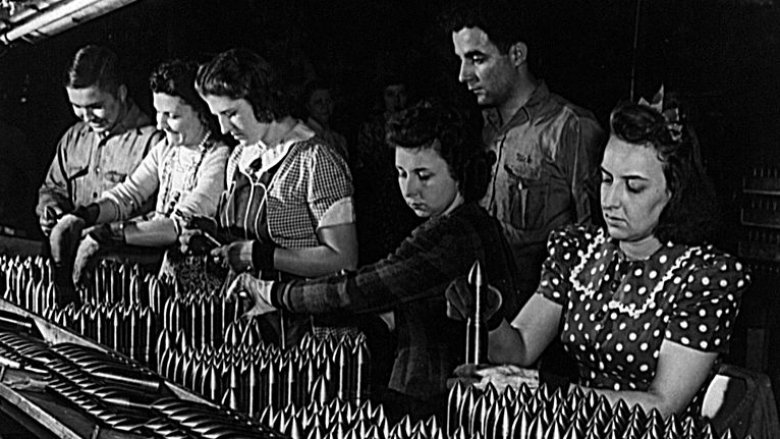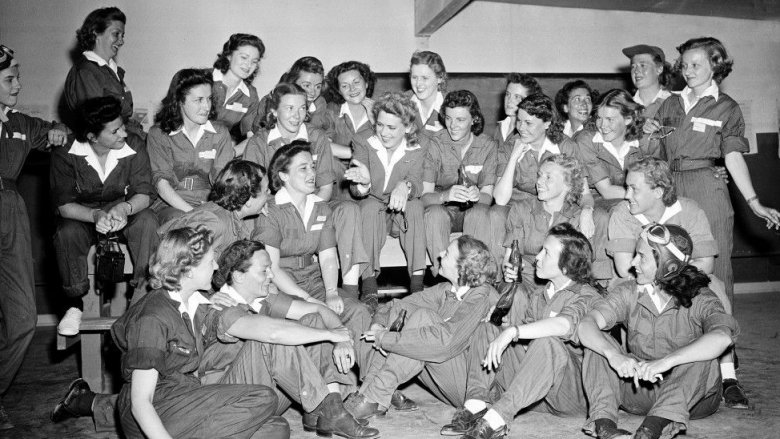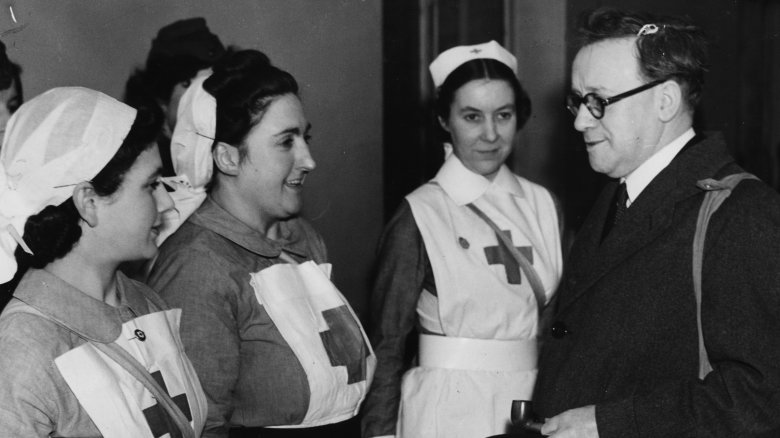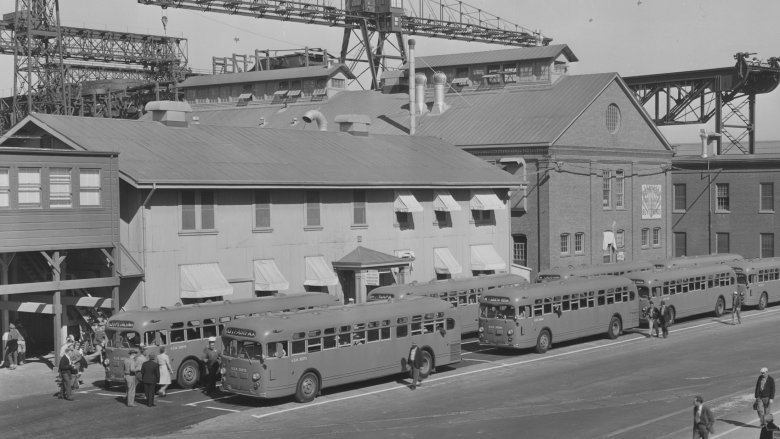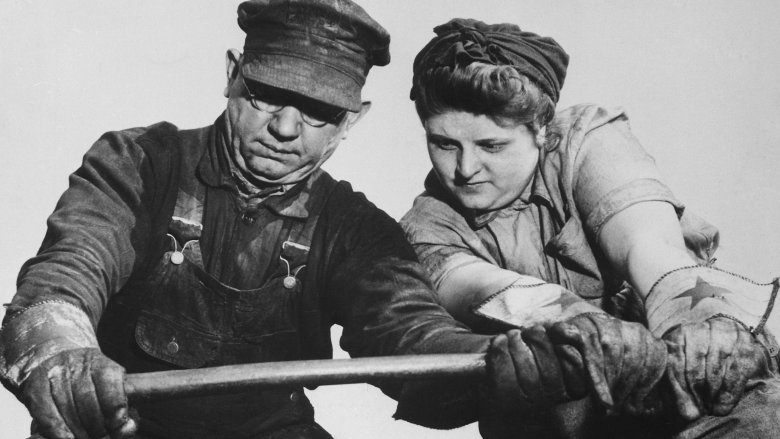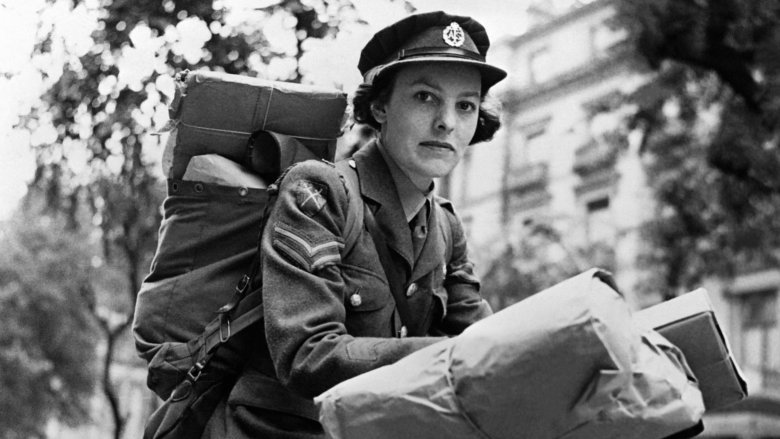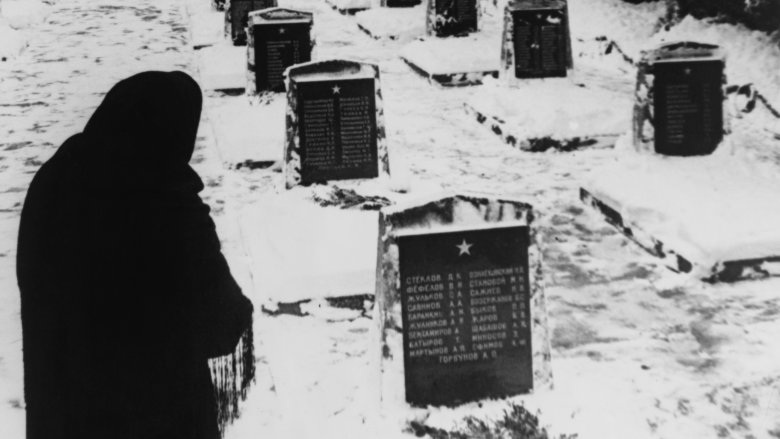What Life Was Really Like For Women During WWII
From a big picture perspective, war is always a terrible thing. Estimates of the total number of casualties during World War II vary greatly between sources, but the National WWII Museum says the war took the lives of approximately 15,000,000 soldiers and more than 45,000,000 civilians (though some estimates place the number of civilian deaths in China alone at more than 50,000,000). So that's terrible, and frankly, if we could just settle our differences without killing each other and blowing up cities, well, the world would be a much better place. But not everything about war is bad. World War II was also a time of progress, both technologically and socially.
Before the 1940s, women were pretty much stuck in the home, relegated to those old gender-based expectations of becoming a wife and and mother and not much else. But during World War II, all kinds of new opportunities opened up for women. Here's what it was like to be female in wartime America, circa 1944.
A lot of women got married young, just before their husbands were shipped out
Most of the young soldiers who fought during World War II didn't join voluntarily, they were "called up." The draft was a very scary reality for a lot of young men, but it was also a very scary reality for young women — not because they had to worry about getting shipped off to a foreign country to fight and possibly die in a war, but because they had worry that that was going to happen to their sweetheart.
According to the National World War II museum, the marriage industry was doing quite a brisk business as young couples decided they'd better get hitched now or not at all. Those hasty marriages helped solidify fledgling relationships across the miles, but they also ensured that young women would be looked after while their husbands were overseas.
In 1942 there were 1.8 million weddings — that was a whopping 83 percent increase over the previous decade. More than two-thirds of these weddings were between a woman and a newly-enlisted man. There were so many weddings, in fact, that some of the people who were actually performing the ceremonies feared that couples might not really know what they were getting into. One rector even wrote a booklet entitled "Marriage Is a Serious Business," which warned against a "hasty marriage, caused by glamour and excitement rather than by genuine affection," calling it "one of the evil products of war."
WWII was great for women's rights
Before a huge percentage of the male population left the country to fight overseas, women were stuck in those tired old gender roles — they were expected to take care of the house, cook the meals, raise the children, and not much else. But with so much of the male workforce absent, US companies found that they needed people rather desperately, and they stopped caring so much whether those people were of the male persuasion. Meanwhile, according to the National World War II Museum, the Germans were reluctant to take women out of those traditional gender roles in order to serve the war effort — women, it was believed, were needed to have Nazi babies with Nazi soldiers.
In America, it was the era of Rosie the Riveter. Even if you don't know her name you're almost certainly familiar with her face. Dressed in a pair of coveralls with a red polka-dot bandana, Rosie was the poster girl for working women during the 1940s. She told women that it was not only okay to leave the home and join the workforce, it was also their patriotic duty.
During World War II, around 6 million women entered the workforce, becoming electricians, welders, engineers, machinists, and other jobs traditionally reserved for men. In fact there's a pretty good argument to be made that without World War II, women might have remained stuck in the home for decades beyond the 40s and 50s.
WWII gave women a reason to learn self-sufficiency
Traditional women's roles include cooking, cleaning, changing diapers, washing diapers because there weren't disposable diapers back then, while asking your husband to check the oil on your car, to change the lightbulbs, and repair broken stuff. Because if a woman picked up a hammer or a wrench or a screwdriver, not only might she no longer have perfect, unbroken skin on her hands, she might also create a rift in the space-time continuum or something.
Before World War II, women didn't typically try to fix things when they broke. They didn't even think they were capable of fixing things up when they broke, largely because men had been telling them for centuries that they're not capable of fixing things that break. But History says that once the men were all off to war, everything changed. Not only were women learning trades that required the use of tools, they also needed to learn to repair things around the house just out of necessity. So the partial absence of men during the war years in America basically taught women that they, well, don't really need men.
We mostly think of feminism as something that was born in the 1960s, but it began long before, with World War II giving it a major boost as large numbers of women traded their wooden spoons for a rivet gun.
Women didn't just work civilian jobs during WWII, either
Women in America weren't drafted, but they were strongly encouraged to join the war effort. According to History, the rousing motto "free a man up to fight" was meant to bring women into the armed forces, you know, so they could feel personally responsible that the guy who used to sit in their warm office answering telephones all day is now out there on the front lines shivering inside a foxhole. But it was all in the name of patriotism.
Anyway, most women — about 70 percent of them — took traditionally female jobs like typing, filing, and sorting mail. But some of them became Naval Intelligence translators, some of them became truck drivers, some were engineers or radio operators — for the most part, they filled positions as they were needed. There was even an all-black, all-female battalion assigned to process mail, which was piling up in enormous quantities. (Just mail processing, though? Really?)
The idea that women could work military jobs (though granted, they were not combat positions) would have been scandalous in another time, but with the dire shortage of men it was suddenly a "golden opportunity." No one wanted to put able-bodied men behind switchboards or in front of filing cabinets when they could be on the front lines. Well, the able-bodied men might have preferred that, but nobody asked them.
For the first time, women could serve as military pilots
Women pilots were not a new idea during World War II — Amelia Earhart made headlines only a few years before the Japanese attack on Pearl Harbor, so it's not like the idea of women flying airplanes was especially shocking or anything. Plenty of women had pilot's licenses, it's just that they weren't allowed to join the Air Force.
After America entered the war, it became clear that the military needed its male pilots out there fighting dogfights, which meant they needed non-male pilots to do some of the more menial tasks, like ferrying airplanes from place to place. The obvious answer: Women's Air Force Service Pilots, or WASPs. According to History, these were the first women to fly military aircraft — they flew new planes from factories to Air Force bases, they flew cargo planes, and they sometimes even participated in target missions and simulation strafing. But officially, they weren't members of the military. As "civil service employees," they were ineligible for military honors or benefits, and it took a very long time before they got the official recognition they deserved. In 2010, the WASPs were finally granted full military status, and they were also awarded the Congressional Gold Medal. It was 65 years too late, but whatever. Better late than never.
During WWII, combat nurses were often in harm's way
Women were still thought of as "the weaker sex" during the 1940s, and most of the time they would be put in "safe" jobs while men were assigned to the more dangerous positions. But not all women's jobs were safe, and combat nursing was one example.
During World War II the need for medical professionals was profound, for pretty obvious reasons. War equals wounds, wounds equal blood loss, and blood loss has to be treated fast or the wounded soldier will die. When you have only minutes to save somebody's life, there isn't time to move that person from the front lines to whatever safe location you put all your nurses in. So combat nurses, by necessity, had to be really close to the front lines. According to History, combat nurses had to endure the mud, cold, and heat, just the same as the male soldiers did, and they were also in physical danger. Near the front lines, they could be killed by aircraft fire or artillery attack.
Women also served as flight nurses — specially-trained combat nurses who understood the specifics of caring for patients at high altitudes. Flight nurses typically worked in unmarked aircraft (the planes doubled as military supply transporters, so they couldn't have a red cross marking), which meant they were vulnerable to attack. So not only were the women of World War II patriotic and capable, they were also pretty danged brave.
One guess if women and men got equal pay during WWII
Once employers realized that women could do those traditionally male roles just as well as men could, they were more than happy to pay their new employees exactly the same salaries as they'd paid the employees they'd lost to the draft. Ha. Hahaha.
No, employers did not compensate their female employees as well as they'd compensated their male employees, because of course they didn't. It was the 1940s, and if people today haven't figured out how to give women and men equal pay for equal work, it's pretty laughable to think that they would have had that figured out in the 40s. Instead, employers basically just viewed their new female workers as cheap temporary labor, and really didn't see why they should have to pay them fairly.
According to Striking Women, there was a halfhearted effort in the United Kingdom to secure equal pay for women during World War II, and employers were supposed to pay them the same as men if they could do the same jobs "without assistance or supervision." That was enough of a loophole that employers still managed to get away with paying their female employees about 53 percent of what they'd been paying the men. Across the pond, it wasn't much better — in 1944 skilled men could expect to earn around $55 a week, while skilled women could earn closer to $31, or about 56 percent of what the men earned.
California, here we come
Wartime industry was booming on the Pacific Coast. Workers were needed in California, and a lot of women made the bold decision to go where the jobs were. With their husbands overseas, the ideal of remaining close to home mattered a lot less.
According to Smithsonian, close to 10 percent of federal government expenditures during World War II were spent in California, and those opportunities attracted people from all over the country, especially from economically disadvantaged states. In fact, the migration to California during World War II was history's largest mass migration within the country's borders. Some federal jobs even came with child care. If you were used to struggling to make ends meet, it was kind of hard to turn down those kinds of opportunities, even if it meant pulling up your roots and traveling halfway across the country to a brand new state.
For a while, it was the California dream. Women from rural farming communities could work in California factories for salaries that were unheard of back home. But alas, even talented, hard-working women couldn't permanently overcome the deep systemic misogyny that still existed in the workplace, and when the war ended a lot of them were dismissed from their jobs so their male counterparts could have their jobs back. Some women returned to their home states, while others found new opportunities in California, which still had more promise than many of the communities they'd come from.
The marriage boom was big, and so was the divorce boom
Before the 1940s, divorce was practically a scandal. After all, "Til death do us part" would not have been in those vows if you weren't supposed to mean it. But it can be pretty hard to survive those long years of separation, especially when the marriage was sort of hasty to begin with.
According to a study published by the American Journal of Sociology in 1990, World War II veterans were more likely to divorce in the years following the war than non-veterans. No one can really say for sure why the divorce rate was so high for veterans, but it seems possible that it had to do with distance and the lack of communication between wives and husbands. After all, there was no such thing as Skype in the 1940s, and soldiers couldn't exactly make phone calls from the front lines. So not only were you separated from your spouse by distance, the only communication you had from him was through letters or telegrams. Letters sometimes took so long to arrive that you had no way of knowing whether he'd been killed after he sent the letter, so there was always the possibility you were reading the last words he'd ever say to you. That kind of stress is pretty hard on a marriage, and it can also elevate your absent spouse to an ideal that he can't possibly hope to uphold when he gets home.
Some people were threatened by working women
It probably will not surprise you hear that not everyone was super enthusiastic about the idea of women in the workplace. Even though it was clearly a positive thing for the war effort, there were still plenty of people who did not think it was appropriate to have women working as engineers or mechanics or, god forbid, pilots. According to the National World War II Museum, the male counterparts of working women didn't exactly welcome them into the workplace. The fact that women proved to be capable workers was threatening to a lot of career males, who saw them as encroaching on work spaces that had been traditionally reserved for men and men alone. And those dudes couldn't just keep it to themselves, either — many disgruntled men thought they needed to fight back, and unfortunately, the weapons they chose were often verbal abuse, harassment, and refusal to treat their female coworkers with the same respect they reserved for fellow males.
Employers — who were greatly benefiting from having women in the workplace — tried to appease everyone by separating the men from the women and, of course, paying women less because obviously. But outside the workplace there was also grumbling — lots of people worried that the basic family structure of the provider husband and the subservient wife was going to unravel, and then eek ... powerful women with voices and independence! Noooo!
The UK actually drafted women in WWII
The United States has never had a tradition of drafting women, but that's not true of other nations. As it became clear that women are just as capable of performing important jobs as men are, some governments decided that equal opportunity meant drafting men and women in equal numbers.
According to the BBC, in the spring of 1941 the UK started requiring all women between the ages of 18 and 60 to register. For the first couple of years, the military was mostly just interested in women between 20 and 30, but by the middle of 1943 something like 90 percent of all unmarried women in the UK and 80 percent of married women were employed in military and war-related jobs. New recruits were told they would not be in harm's way, but because Britain was a frequent target for German aircraft, that promise wasn't really good for much.
Women in the UK, like women across the pond, performed admirably in their jobs, and like American women, they made less than the men did. So much for equal opportunity.
In conflict zones, women were often victims of violence
Since the beginning of time, violence against women has been one of the side effects of war. You might imagine that we've come a long way since then, and we sort of have — these days there are international laws against harming civilians during wartime, and it's no longer something soldiers feel entitled to do. But that doesn't mean it doesn't happen anymore.
According to Cambridge Core, roughly 1.4 to 1.9 million German women were victims of sexual violence during World War II, mostly perpetrated by Russian soldiers. About 10 percent of those women committed suicide after their ordeal. And the Russians didn't exactly have a monopoly on wartime violence against women, either — U.S., French, and German soldiers did it, too, and justified it as something that they could do to "enemy women."
Even consensual couplings were frowned upon, especially if it was between a woman and an enemy soldier. After the war was over, women in countries that had been occupied by the Germans could face punishment for being "sexual collaborators," or for providing "comfort" to the enemy, so it didn't really matter if it was a violent encounter or a consensual one, women were still had to endure the dire consequences.
